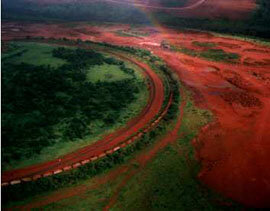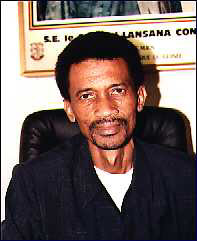 BAUXITE BAUXITE
 SECOND LARGEST BAUXITE PROCUCER IN THE WORLD SECOND LARGEST BAUXITE PROCUCER IN THE WORLD
Guinea Contains 30% of the world bauxite reserves. In fact all over the country it is possible to see the red scars left by bauxite mixed with iron ore. Bauxite mines have long since been working in Guinea, the second largest producer of bauxite in the globe. Production is carried out by some mining giants. The Compagnie des Bauxites de Guinée (CBG) is the single biggest mining society in Africa, and Friguia is the only alumina factory in the continent. The Société des Bauxites de Kindia (SBK) exports virtually all its production to Ukraine. And SBDT, is soon to start production destined to the Iranian market.
 CBG: AN AFRICAN MINING GIANT CBG: AN AFRICAN MINING GIANT
The Compagnie des Bauxites de Guinée (CBG) is the single largest bauxite producer in Guinea.

Forecasted production for 1998 is 12,8 million tons. CBG’s bauxite is very appreciated due to the high aluminum content of its Sangaredi mine production (60% purity). However after 25 years of exploitation this open pit mine is starting to deplete (in 1995 CBG shipped its 200 millionth ton). This has pushed CBG to find new deposits, but so far the aluminum content has been considerably inferior. This does not favor CBG, since bauxite and aluminum prices have been steadily dropping in international markets, and competition is fierce. Therefore CBG’s projections for further production in the near future start at 13,5 million tons, ending up at 15 million tons. This way they could mix high quality mineral with lower quality, obtaining 54% purity.
Despite all this, CBG’s vice-president, Mr. Gérard Coker, a well traveled and perfectly bilingual gentleman, does not worry about the future. The reason is simple. CBG was created to satisfy the needs of some of the largest aluminum companies in the world. This means Sangaredi is a captive mine. All its production is sold beforehand to CBG shareholders: the Guinean State (49%) and HALCO, a consortium of the largest aluminum companies in the world: Alcoa (USA), Alcan (Canada), P‚chiney (France), WAW (Germany), Comalco (Australia) and Reynolds (USA). Exports are carried out from CBG’s own port. Just to give an example of its capacity, a 60,000 ton ship can be loaded in 18 hours. 233 ships were loaded in 1995. All operations: blasting, transporting, crushing, stocking, drying and shiploading are, step by step, computer monitored.
The socio-economical impact of CBG is immense. After the State it is the largest employer in Guinea: 2,700 workers trained by the company. It brings into the country 80% of total foreign exchange revenues. But most importantly it has significantly developed the region where they are established. The mining city at Kamsar and site (Sangaredi) count with all necessary facilities hosting hospitals, schools, cultural centers, hotels, mosques, a church and even a TV and radio station. Housing is provided for all workers.
|

 SBK: STRUGGLING TO SURVIVE SBK: STRUGGLING TO SURVIVE
After its independence in 1958 Guinea was soon confronted with financial problems. The newborn country desperately needed foreign help, and found it in the USSR. In 1969 the Office des Bauxites de Kindia (OBK) was thus born out of Guinean-Soviet cooperation. All of its production was then destined to Soviet republics, especially to Nikolaev aluminum refinery in Ukraine. OBK bartered bauxite against primary needs from the Soviet Union while helping to pay off Guinea’s trade debts. The fall of communism and disintegration of the Soviet Union meant a severe blow for the OBK. 3 years later, in 1993, OBK changed its status to a limited liability corporation becoming the Societé des Bauxites de Kindia (SBK).
Today SBK is struggling to survive. Its former captive market, the Soviet block, is having serious financial problems. Supply of spare pieces and mining material from Russia has also become difficult, and they have to confront serious maintenance problems. Production has decreased from 2,3 million tons in 1993 to 1,4 million tons in 1997.
Nevertheless SBK’s director general, Mr. Ibrahima Bah is determined to save his dear company. The company has undergone severe restructuring, cutting down expenses and staff and modernizing its management. Warburg Dillon Reed, a British-Swiss bank is elaborating a study for the restructuring of the company within the framework of the development project for the mining sector in Guinea financed by the World Bank. The mineral extracted by SBK has weak reactive silicon and monohydrate Contents, making it ideal for aluminum factories working at low temperatures such as Corpus Christy in Texas, Vaudreuil in Canada or San Ciprian in Spain. Exploitable reserves are 57 million tons, which mean at least 10 more years of production. Although real production fluctuates between 2 and 2,5 million tons/year, installed capacity is 3 million ton/year. Delivery to Nikolaev refinery still continues, but SBK wants to spread risks, so one of its main concerns is finding international partners to help them renew their aging plant in order to attain again world class status. |

